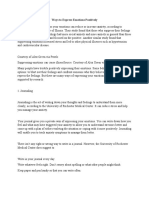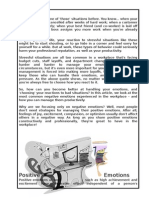0% found this document useful (0 votes)
48 views10 pagesPer Dev
The document discusses difficult emotions such as sadness, anger, fear, and frustration, highlighting common internal and external triggers, as well as the impact of past experiences. It offers strategies for managing these emotions, including self-awareness, mindfulness, self-compassion, seeking support, and problem-solving. The emphasis is on recognizing emotions, practicing acceptance, and taking actionable steps to address their causes.
Uploaded by
queendayannereyesCopyright
© © All Rights Reserved
We take content rights seriously. If you suspect this is your content, claim it here.
Available Formats
Download as PDF, TXT or read online on Scribd
0% found this document useful (0 votes)
48 views10 pagesPer Dev
The document discusses difficult emotions such as sadness, anger, fear, and frustration, highlighting common internal and external triggers, as well as the impact of past experiences. It offers strategies for managing these emotions, including self-awareness, mindfulness, self-compassion, seeking support, and problem-solving. The emphasis is on recognizing emotions, practicing acceptance, and taking actionable steps to address their causes.
Uploaded by
queendayannereyesCopyright
© © All Rights Reserved
We take content rights seriously. If you suspect this is your content, claim it here.
Available Formats
Download as PDF, TXT or read online on Scribd
/ 10































































